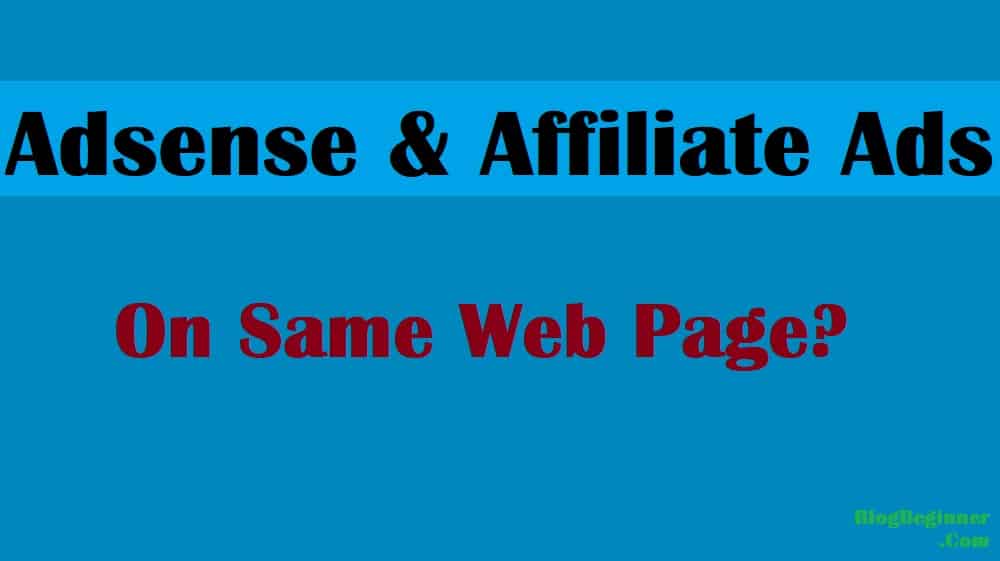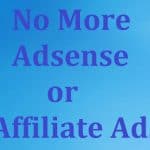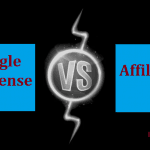Being a newbie in the blogging world means finding answers to different elements of blogging. One of the areas of blogging that attracts the biggest number of questions is monetization.
Every blogger wishes to earn from their blog using any and every means possible.
So, you will find yourself wondering if there will be a conflict of interest if you choose to run AdSense ads and Amazon Affiliate ads.
Well, the good news is that you can run these two types of ads on your blog.
The reason for this is that AdSense represents a form of contextual ad network and the only catch is that you cannot run other types of network ads that mimic AdSense ads.
So, yes.
Contents In Page
You can run the AdSense ads and the Affiliate Ads on your blog
Note, that running either form of advertisement depends on factors such as your niche, the traffic your site receives, and even whether you have an email list or not.
But, since we are focusing on monetization, you might want to use both options.
For most bloggers, starting with one monetization strategy and learning all the ropes is the way to go. And, this often works with bloggers recording hundreds to thousands of active visitors daily, after some months.
The success in one strategy often means bringing on board the next strategy so that when you combine the two strategies, the large traffic to your site translates into a huge difference in your bottom line, even with the smallest increase in the conversions.
Before we look at the two ways of monetizing your blog, we have to talk about the element that determines when you get to use Google AdSense and when you can use the Affiliate Ads – content.
In online advertisement, like digital marketing, content is crucial in determining the popularity (ranking) of your site, and in this case, traffic (which translates to visitors).
To get the most out of Google AdSense, you should think of creating informational content. Basically, your content shouldn’t be selling products or services.
For affiliate ads, on the other hand, your content should be geared towards selling products – the content should align with the products for visitors to click on the product link and even purchase it.
Therefore, it is not a great idea to promote products in every article, unless you are running a product review site.
For both types of ads to run on your blog, you might want to write general educational content on your niche. Such content lets you display content across your site.
Is there a limit to the number of ads you can run?
It is not written anywhere but, you do not want your blog content to appear spammy. Avoid placing affiliate links throughout your content. A maximum of 3 links is recommended.
Also, remember that when promoting affiliate products, the primary objective of that page should be getting people to click on that affiliate link rather than the ad.
So, how do you monetize your blog with Google AdSense and Affiliate ads?
Monetizing your blog with Google AdSense
Google AdSense is the most popular ad networks which allows you to make money by only displaying ads on your blog or website.
With Google AdSense, you make money in two ways: first, through impressions (this depends on your page’s views) and you earn based on the impressions your page gets.
You set your dollar amount to be based on the total number of page views your page records. The second method is based on clicks. The pageviews do not matter, and you set the amount of earned money based on the times visitors click on the ad displayed on your site.
Whether you choose to monetize your blog with impressions or clicks, your earnings are tied to the traffic recorded on your website, as well as the number of visitors to your site.
To use this monetizing option,
Create your AdSense account then indicate where you wish the ads to be displayed on your blog. You also get the right to choose the number of ads you wish displayed on your blog. Under your AdSense account, sign up for the blogger account then select the blog you want ads to run on. Then, click on Earnings and Sign up for AdSense. If you don’t see the Sign up for AdSense button, it could mean that your blog doesn’t meet the AdSense eligibility criteria.
New account applications take up to 48 hours to be reviewed.
For ads to appear between posts:
- Sign into Blogger then click on the Down Arrow in the top left. Select the blog you wish to display ads and in the left menu click on layout.
- Templates vary. So, you might have to choose Page Body or Main under Blog Posts and click Edit. In the Edit window, check the Show Ads Between Ads box. Before you click save, don’t forget to select your preferred ad format, the color, and the frequency with which the ads will appear.
Monetizing your blog with Affiliate Ads
Affiliate advertising represents the online advertising channel where an advertiser pays said blogger to promote their products/ services on the blogger’s blog or website.
Affiliate ads come in three main forms: pay-per-click, pay-per-sale, and pay-per-lead.
All these types of ads are performance-based meaning that as a blogger, you will not earn a dime unless your readers act by clicking on the link or clicking on the link and buying the product being promoted by the link.
Amazon Associates and eBay Partner Networks are examples of retail affiliate programs for advertising.
Some of the best avenues of affiliate advertising include the use of classified ads, writing e-books, creating YouTube videos, running pay-per-click ads, and blogging.
Blogging is one of the most effective strategies, especially if you create high-quality content which ranks high, and attracts great traffic. It also works great because the blog will be available 24/7.
In affiliate marketing, you include links to the product/ service offered using another business’ affiliate program. If a visitor clicks on the link and purchases the product/ service, you receive a commission.
For you to make the most out of affiliate marketing and advertising, you must know your target audience.
It’s only after asking the right/ relevant questions and observing the behavior of your web visitors that you can create high-value content that pushes your readers to act.
Also, be careful about the products you advertise on your platform and always look for the best and high-converting affiliate offers.
The product(s) you promote should be relevant to your niche, promote products you would use, and always include a disclaimer not to mislead the readers.
Conclusion:
Even though both advertising channels help increase your earnings from the blog, the best option depends on your goals.
If you are looking to make passive income, Google AdSense makes more sense.
On the other hand, if yours is a niche blog market and business or people looking to establish themselves and build a professional reputation and network, then affiliate marketing works.








